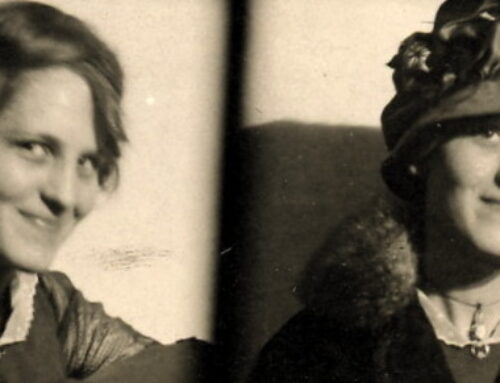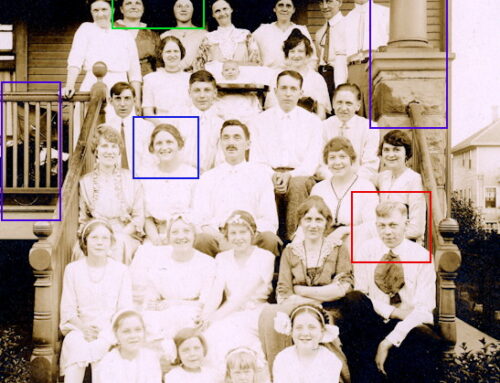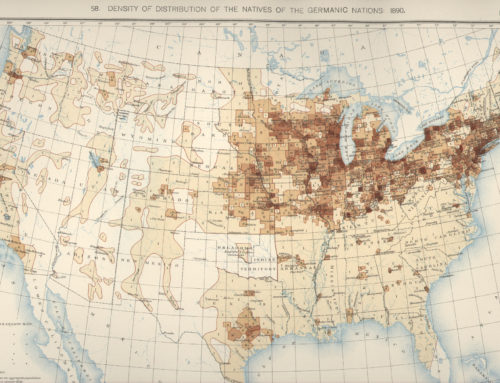This post is about finding Austrian ancestors in Ladis.
Long-time readers here know (probably too much!) about my multi-year genealogical pilgrimage to visit the European villages of my immigrant great-grandparents. Each of the eight arrived in Chicago during the Third Wave of Immigration from Europe to the U.S. between 1880 and 1920.
Finding Austrian Ancestors in Ladis
This fifth visit brought my husband and me to Ladis, the Austrian Alpine hometown of my father’s mother’s father Gottfried Ernst Hann. From the beginning, this visit to the Tyrolean region of Austria felt different from other trips. I felt more connected to this place, possibly because I’d worked so hard to uncover information about Gottfried. Perhaps another reason I felt so attached was that my great-grandfather had a brief and difficult life.

Postcard of Ladis, Austria, circa 1900, about 15 years after my great-grandfather left for the U.S.
Researching Gottfried Hann
Gottfried died at 35, two months before my grandmother was born in Chicago. So very little was known about Gottfried in the family. In fact, my baby book entry lists him as “Mannfried ? Hann.” When I asked my father about him years ago, he said Gottfried came to the U.S. with only his lederhosen and was a “tearoller.” Was this an occupation? Gottfried rolled tea leaves for a living, like cigar rollers made cigars? No, my father laughed, it meant he was from the Tyrol region of Austria. These skimpy facts made Gottfried, at least initially, the brickiest of my brick walls.
However, by the time I was planning this trip, I’d not only discovered his origins in Austria. But I’d also found his confirmation record in the Catholic Church in Ladis. An Austrian professional genealogist, who searched otherwise closed diocesan records in Innsbruck for me.

Confirmation Record of Gottfried Hann at age 9 1/2, St. Martin Catholic Church, Ladis, Austria, 2 Nov 1870 | parents Johan Georg Hann and Nothberg Schenk | godparent Josef Ringgold, whose occupation looks like Kreisfsmsstsigartabstnid to me. (True occupation will be discovered after I improve my reading ability in the SLIG course on German translation in January.)
Getting to Ladis
As we entered Austria and drove toward our resort destination of Seefeld, I saw exits off the autobahn for the villages I’d researched for so long and needed to visit. And I learned that Oetzi the Iceman was discovered close by my villages.
Despite my hair-raising driving adventures in Scotland last summer, my husband was ready for another genealogy excursion, this time on the Austrian autobahn and through the Alps. Brave man! Barbara, the owner of the Alte Schmeide, our hotel in Seefeld, moved heaven and earth to find a rental car for us. Soon we were off on our day-long ancestral trip through the Alps with the best wishes of our friends from the tour group.
Unfortunately, George did not believe me when I said it was a local rule that men had to dress in lederhosen to be admitted to Ladis. Otherwise, I would be showing you pictures of his knees (they’re very nice) right here. Instead, here’s a picture of the family that owns the Alte Schmeide Hotel, who made our visit to Ladis possible.

Barbara (center in the green blouse) is the wonderful hotelier who saved my ancestral trip to Austria. Thank you, Barbara!
Tyrolean Villages
My great-great grandfather’s family lived in this region of the Tyrol (German: Tirol, Italian: Tirolo) for centuries. So I prioritized my village list: first Ladis, then Fiss and Serfaus on the same Alpine plateau; then Fleiß; then Schönweiss, where my great-grandmother’s family were baptized, and Starkenbach, where they were born.
We reached Ladis, courtesy of the Inntal autobahn, the 4.5-mile Landecker tunnel, and a dozen numbered (all the better to find you in an avalanche) hairpin turns. Ladis is a picture-book Austrian village, complete with a mirror lake, lovely old buildings and gasthauses, Laudegg Castle, and an imposing Catholic church. Today is it a bustling hub for Nordic hiking in the summer and skiing in the winter.
Parking our rental car was surprisingly not a problem in this tiny village. Minuscule parking lots were half empty, as most people seemed to arrive on foot after hiking up and down 14,000-foot peaks without a care. “I cheated and took the bus from Serfaus to Ladis because I’ve done so many peaks today,” confided one hiker we met. She was in her 70s, nut-brown, laden with a serious daypack, and could out-climb my soft American self any day of the week.
My husband was all for hiking to the next ancestral village via many Alpine peaks. I voted for a gasthaus with some Weiner Schnitzel, apfelstrudel, and lots of coffee, followed by a visit to the local church. Guess who won?

George was so inspired by the Alpine peaks that he started warming up for a days-long Nordic hike with nothing but my genealogy printouts and an RxBar in his rucksack. (Edit: he says there were *two* RxBars in his ruck.)

The mountain bike trails between villages seemed crazy dangerous to me. (Courtesy www.serfaus-fiss-ladis.at)

Bring your skis to visit Serfaus, Fiss, and Ladis in the winter. I’ll be the person sitting by the fire in a Ladis hotel with all my moveable limbs, getting some research done while staying nice and warm.
Saint Martin Catholic Church
It’s never a problem to find the Catholic church in an Austrian village. Their steeples – complete with clocks – dominate the skyline as well as the “zentrum” or town square in every village.

Saint Martin Catholic Church in Ladis was predictably imposing, perched on a reinforced hilltop.

St. Martin churchyard under renovation. I think my 17th- and 18th-century Ladis ancestors are about four levels deep in this cemetery.
When we arrived, backhoes and workers were busy renovating the tiny cemetery in the churchyard. The distinctive Austrian metal cross headstones from the mid- to late-20th century were put to one side. But on an exterior church wall, I found this memorial. More research to do, but I think this could be a great-great uncle.

When we entered the church, we discovered mostly Gothic and Romanesque features in this ornate village church. As we continued through the area, we found the same features in other small Catholic churches, with Byzantine touches as well.

The church where my great-grandfather was confirmed in 1870.
Our visit to Ladis was a satisfying success. (The other villages on our day trip will have to wait for another post.) As always, thanks to my husband for serving as navigator, expeditor, picture-taker, surname searcher of cemeteries and churchyards, and carrier of heavy packs on our ancestral adventures.

Portrait of the happy genealogist in Ladis.
Leaving the Sonnenplateau
A YouTuber (not us!) filmed the route from Fiss back to the autobahn, which is a great way to conclude this post about finding Austrian ancestors in Ladis. (Warning: loud music on this video, so turn down your speakers if you’re watching at work.)
Heritage travel completed:
- Ringebu, Norway
- Øvre Eiker, Norway
- Dunnottar, Scotland
- Tain, Scotland
- Ladis, Austria
Next up: Prussian ancestors. Stay tuned.





Leave a Reply